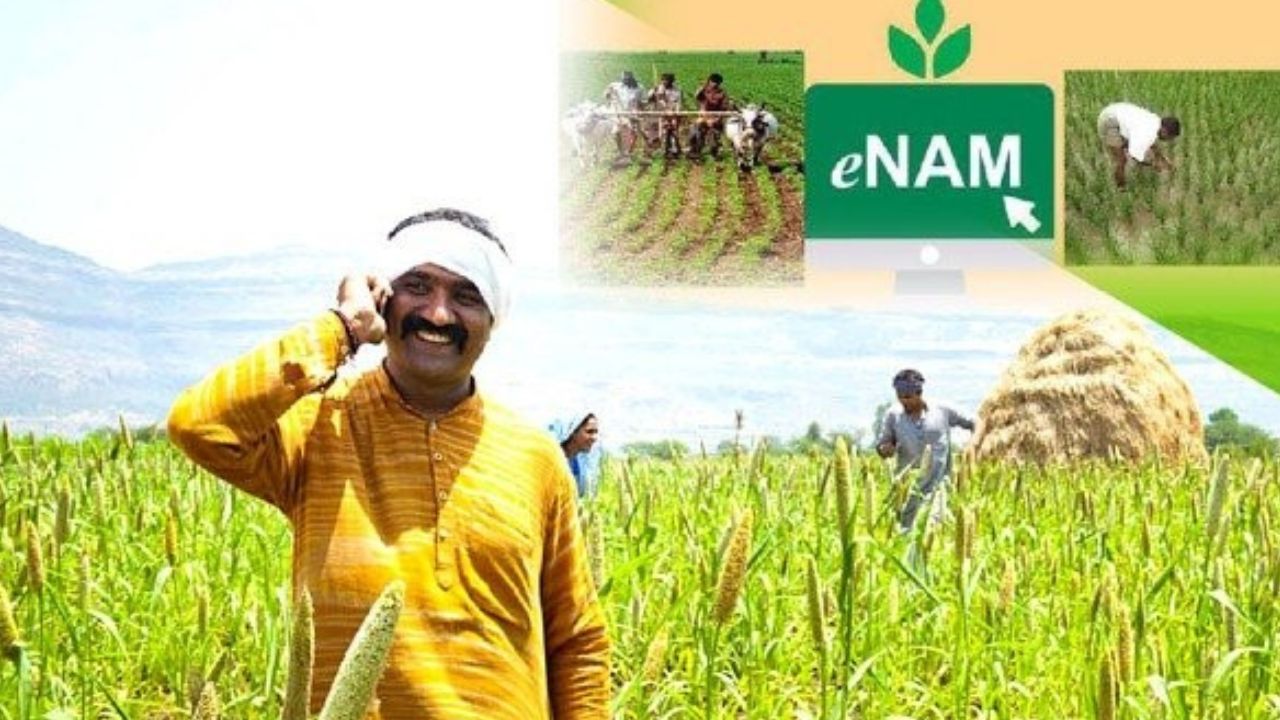For generations, the Indian farmer has faced a fundamental challenge that begins right after the harvest: selling their produce. The traditional agricultural marketing system has been dominated by a network of fragmented, local markets or mandis, governed by state-specific Agricultural Produce Market Committee (APMC) acts. This system often left farmers with limited choices, forcing them to sell to a handful of local traders, with little price transparency and a high dependency on commission agents.
To break down these physical and regulatory barriers, the Government of India launched the National Agriculture Market (e-NAM) on April 14, 2016. It is a groundbreaking digital initiative designed to connect these isolated mandis onto a single, online platform. The goal is to create a unified national market, empowering farmers with greater bargaining power and access to a wider pool of buyers.
What is e-NAM? The Digital Mandi
- Full Name: National Agriculture Market (e-NAM)
- Launched: April 14, 2016
- Ministry: Ministry of Agriculture & Farmers Welfare
- The Vision: “One Nation, One Market.” The core idea of e-NAM is not to replace the physical
mandisbut to integrate them. It’s a pan-India electronic trading portal that networks the existing APMCmandisto create a single, transparent marketplace for agricultural commodities.
How Does e-NAM Work? The Process Explained
The platform digitizes and streamlines the entire process of selling agricultural produce.
1. Integration of Mandis
The process begins with integrating existing APMC mandis with the online platform. The government provides the necessary financial assistance and technical support to these mandis to set up the required infrastructure, including computers, internet connectivity, and quality assaying laboratories.
2. Quality Assaying
This is a critical step for building trust in online trading. When a farmer brings their produce to an e-NAM enabled mandi, a sample is taken and tested for key quality parameters like moisture content, size, and impurities. A quality certificate is then generated, which is uploaded online.
3. Online Bidding
The details of the farmer’s produce (the “lot”), along with its quality report, are listed on the e-NAM portal. Licensed traders, who can be physically present in that mandi or located in any other e-NAM mandi across the state or even the country, can then view the lot and participate in a competitive online auction.
4. Sale and Direct Payment
The farmer can see all the bids in real-time on a screen or their mobile phone. They have the power to accept the highest bid. Once the sale is confirmed, the payment is transferred directly into the farmer’s bank account through the e-NAM portal, ensuring timely and transparent transactions.
Key Benefits of the e-NAM Platform
For Farmers:
- Transparent Price Discovery: The competitive online bidding process ensures that farmers get the best possible price for their produce, breaking the cartelization of local traders.
- Wider Market Access: Farmers are no longer captive to their local
mandi. Their produce is visible to a much larger network of buyers, increasing demand and competition. - Direct and Timely Payments: The system of direct online payments reduces the risk of delayed payments and exploitation by intermediaries.
For Traders and Buyers:
- Traders get access to a much larger pool of produce from different
mandison a single platform, improving their sourcing efficiency. - Buyers like large food processing companies can directly source quality-certified produce from farmers, creating a more efficient supply chain.
The Human Touch: A Farmer’s Better Bargain
Mukesh, a turmeric farmer from a small village, used to dread going to his local mandi. Year after year, he would be forced to sell his high-quality turmeric to a few local traders who would collectively set a low price, leaving him with a meager profit.
Last year, his mandi was integrated with the e-NAM platform. When he took his produce this time, it was scientifically graded and assayed. His lot was uploaded online with its quality certificate. To his surprise, the online auction attracted bids not just from the local traders but also from a large spice company located in another state. The final price he received was nearly 20% higher than what he had ever gotten before. The payment was credited directly to his bank account the very next day. For Mukesh, e-NAM was not just a piece of technology; it was a tool that gave him the power to get a fair price for his hard work.
Challenges and the Road Ahead
While the concept is powerful, the implementation faces several challenges.
- Uniform Quality Standards: Establishing and strictly enforcing uniform quality grading and assaying standards across hundreds of
mandisis essential to build trust among distant buyers. - Digital Literacy: A significant number of farmers and traditional traders still lack the digital skills to participate comfortably in online auctions.
- State-Level APMC Reforms: The full potential of e-NAM can only be unlocked when all states reform their APMC acts to allow for a single trading license valid across the state and seamless inter-state trade.
- Logistics: The physical movement of goods after an online sale requires a robust network of logistics, warehousing, and transport, which is still developing.
Conclusion
The National Agriculture Market (e-NAM) is a landmark reform aimed at transforming India’s centuries-old agricultural marketing system. By leveraging technology, it seeks to empower farmers, enhance transparency, and create a more efficient and integrated national market. While the journey to overcome challenges related to infrastructure, policy, and digital literacy is ongoing, e-NAM has successfully laid the digital foundation for a future where every farmer has the power to discover the best price for their produce, breaking free from the constraints of geography and local monopolies.
